The traditional Cornish Pasty dates back to the 13th century and is a pie that squeezes a great deal from pastry, beef, swede and potatoes!
Whether you serve them for dinner or stick them in your lunchbox, these treats are the ultimate British pie!
Homemade Cornish Pasties
Cornish Pasties dates back to the 13th century and unsurprisingly is the source of much discussion, when I say discussion I mean argument!
However, to call this dish famous in the UK would be an understatement.
Any foodstuff name-checked in classics like the Robin Hood Chronicles, the Canterbury Tales and no less than three works of Shakespeare is no shrinking violet.
In short, the humble Cornish pasty is nothing more than a ‘hand pie’ as I see them called on the web. The filling is with four very good things and some salt and pepper.
Those four things are Potato, Onion, Swede (rutabaga elsewhere) and finally beef. It is then seasoned and wrapped in a pastry.
Traditionally food of Cornish ‘miners’, if rumour is to be believed. The crimped crust serves as a handhold and was discarded, because, well mucky hands of course.
I’ll leave you with one final bit of pasty trivia. A pasty crimped by a
Frequently Asked Questions
What pastry should I use?
Without reservation, I recommend making your own pastry for a Cornish pasty.
Shortcrust pastry is used for a traditional Cornish Pasty. Mixing half butter and half beef dripping is the perfect mix as far as I am concerned. It is simple and all you have to do is work cold and use a food processor.
Can I use store-bought pastry?
You can, store-bought shortcrust pastry is pretty good, but the sizes of packets are not ideal. However, you can freeze the leftover pastry and use it at a later date.
What cut of beef should I use?
Traditionally skirt or flank is used as the filling for Cornish pasties, however, I have used both rump and sirloin in the past and it works just fine.
Some recipes suggest using turnip and not swede, what is traditional?
This is often confusing for the simple fact that a swede is a turnip, but not all turnips are swedes.
Traditionally the yellow flashed turnip aka swede or rutabaga is used, however, in Cornwall (and other places in the UK), a swede is just called a turnip.
Does the type of potato make a difference?
Yes, the potatoes for a Cornish pasty should be waxy so that they hold their form and texture. Although I must confess that I do have a weakness for occasionally using a floury potato like King Edwards or Maris Pipers.
How to Crimp a Pasty
Crimping pasties may seem tricky but with a bit of practice it is quite easy, here is a visual guide as to how I do it. The images are from my Cheese and Onion Pasty recipe but the process is identical:
1: Fill the centre of the pasty with your filling leaving around 25mm (1″) at the edges, then brush the edge with water. Using your finger is the easiest way to do this.
2: Fold over the pastry to form a half-moon shape.
3: Press the edges to form a seal.
4: Pick up the pasty in your “dominant” hand with one end of the half-moon shape pointed at you. Take the corner of the pastry between your thumb and forefinger with your thumb at the top and fold the pastry over at a 45° angle.
5: Move along the pasty and repeat the process. But this time squeeze to seal and pull back the finger at the bottom of the pasty to form a lobe, then fold over to create the crimp.
6: Repeat this process working around the pasty, turning as you go so that your hand stays in the same position.
7: When you get to the end, fold the final crimp under the pasty.
Serving Suggestions
I’d usually munch on a Cornish pasty for lunch and maybe add a big dollop of piccalilli or some other type of chutney or pickle.
However, as a kid, I would have them with chips… yes more potatoes and baked beans and I love it.
They are also fantastic as part of a picnic, throw in a couple of scotch eggs or some cheese and bacon turnovers and some salad and you are laughing.
Equipment Used
I only name-check brands of equipment if I think that they make a material difference to a recipe. But, if you have any questions feel free to ask them in the comments section below the recipe.
- Oven.
- Baking tray.
- Mixing bowl.
- Chopping board.
- Kicthen knife.
- Vegetable peeler.
- Weighing scales and or measuring cups and spoons.
- Food processor to make the pastry, you can do this by hand if you wish.
- Cling film.
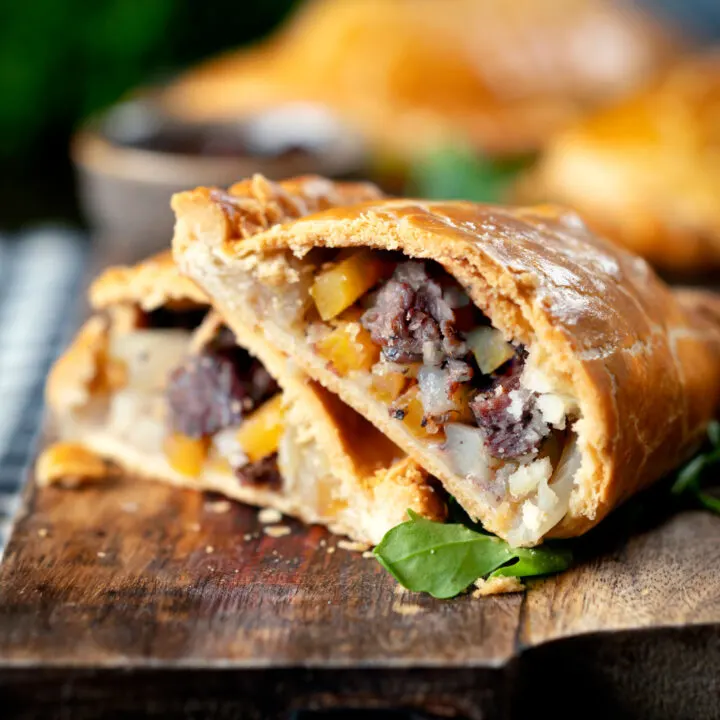
Traditional Cornish Pasty
A traditional Cornish Pasty is what Americans know as a hand pie, filled with very simple ingredients it is hard to believe just how much flavour these beef pies have!
Ingredients
For the Pastry
- 400g (3 Cups) Plain Flour
- 100g (⅓ Cup) Butter
- 100g (⅓ Cup) Beef Dripping
- 6-7 Tbsp Water
- Pinch of Salt
- 1 Egg for glazing the pastry
- Pinch of coarse sea salt
For the Filling:
- 250g (9oz) Beef Skirt or Flank
- 1 Small (75g or ½ Cup) Onion
- 1 Small (125g or 1 Cup) Waxy Potato
- 125g (1 Cup) Swede
- 1½ Tsp Coarse Sea Salt
- ¾-1 Tsp Coarsely Ground Black Pepper
Instructions
- Weigh the flour into the bowl of a food processor and place it in the fridge.
- Grate the beef dripping and butter, and place them in a bowl in the freezer for 10 minutes.
- Add the vegetable fat and butter to the flour, add the pinch of salt and then pulse to create a breadcrumb-like texture.
- Add the water little by little until a ball forms in the food processor, it is important that you do not overwork the dough.
- Move the pastry to a work surface and form 4 hockey puck-shaped rounds (this will make it easier to roll them later), then wrap in cling film and let the pastry sit for 30 minutes to 1 hour. You can leave it for longer if you wish.
- Cut the beef into 2cm (¾) long strips around 5-6mm (¼") in profile and place into a mixing bowl.
- Top and tail the onion, then cut it in half and peel it. Cut the onion halves into 5-6mm (¼") thick strips from top to bottom and add them to the beef.
- Peel the potatoes and then cut the potato into "chips" around 20mmx3-4mmx10mm (¾"x⅛"½") and add it to the pasty filling.
- Peel and cut the swede into "chips" the same size as the potato and throw it in with the rest of the ingredients.
- Add the salt and pepper, give everything a good mix and set aside.
- Roll out the pastry so that it is 3-4mm (around ⅛") thick and cut each out 4 x 225mm (9") circles.
- Add a quarter of the pasty filling to one half of the pastry disc forming a "rugby ball" shape leaving around 2.5cm or 1" of pastry at the edge.
- Brush the edge facing you with a little water, fold over the pastry, and push down to seal the edges. Then crimp by pinching between your thumb and forefinger, pull and twist, then move on to the next crimp. There is a visual guide for doing this further up the page.
- Beat the egg and then brush this over the pasties, then give them a sprinkle with coarse sea salt (this is not traditional but I love it).
- Bake in the oven at 200°C or 390°F for 45 minutes.
Nutrition Information:
Yield:
4Serving Size:
1Amount Per Serving: Calories: 838Total Fat: 48gSaturated Fat: 21gTrans Fat: 1gUnsaturated Fat: 22gCholesterol: 167mgSodium: 1108mgCarbohydrates: 68gFiber: 4gSugar: 7gProtein: 32g

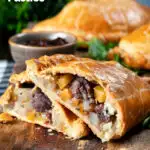
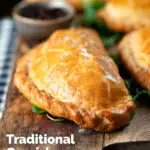



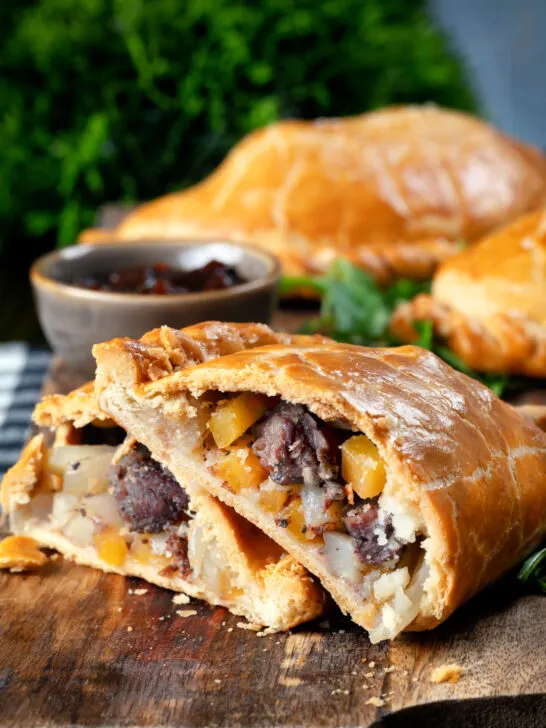
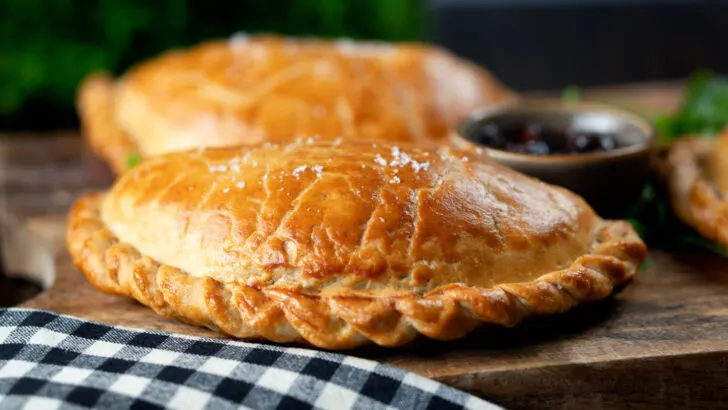
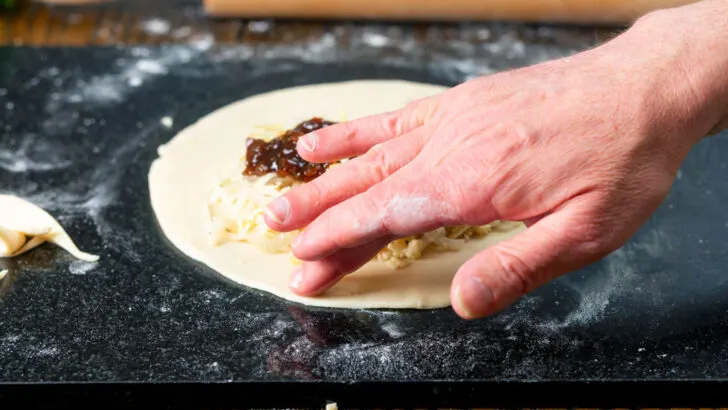
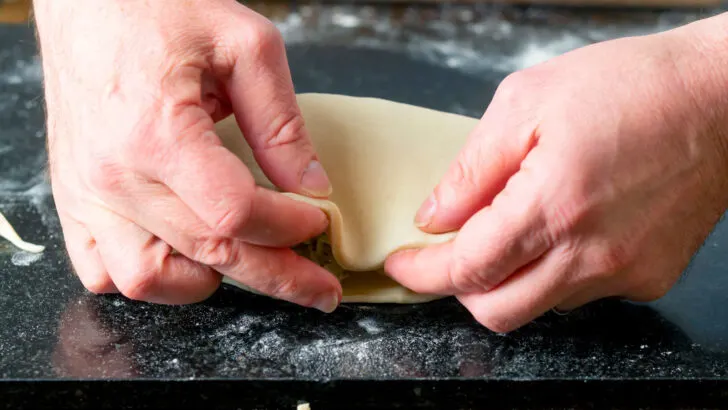
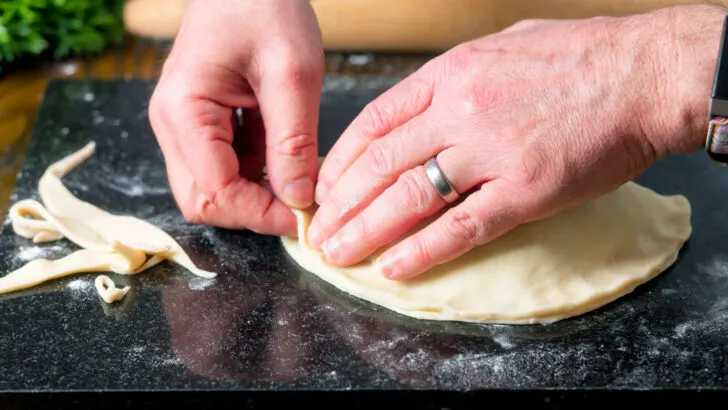
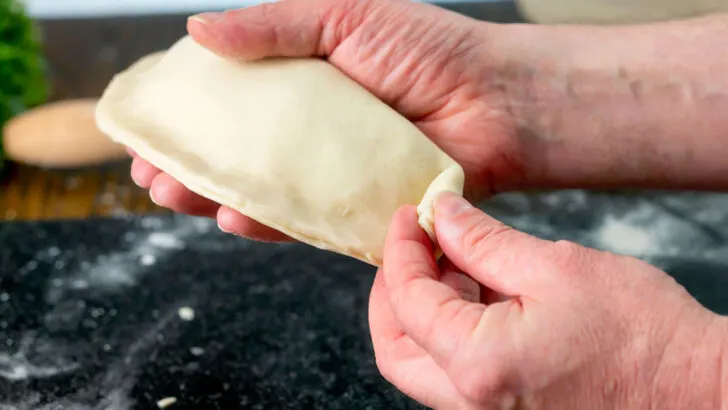
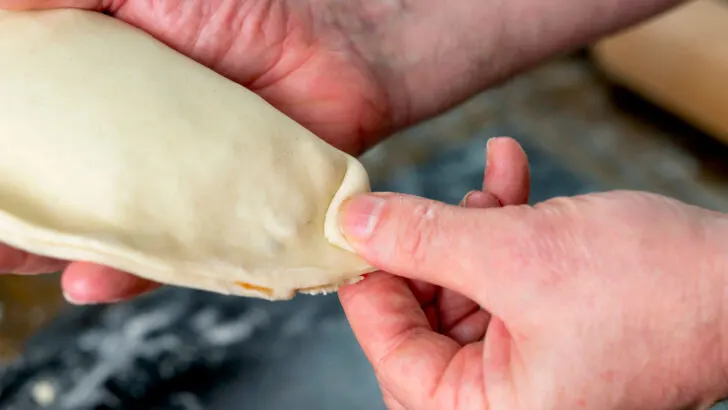
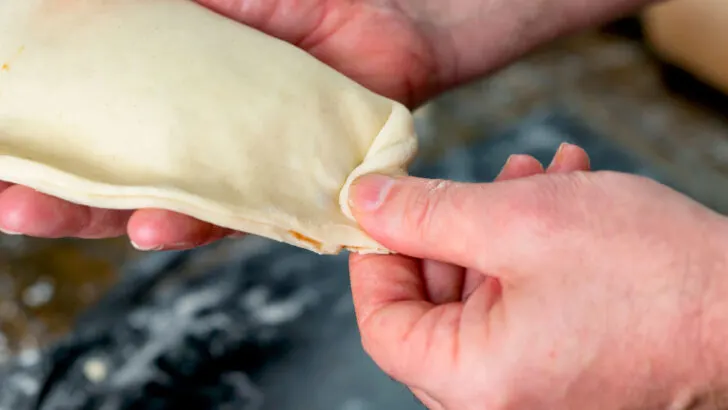
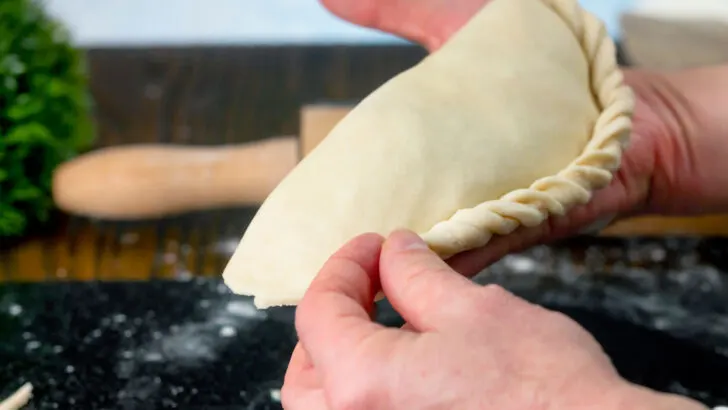
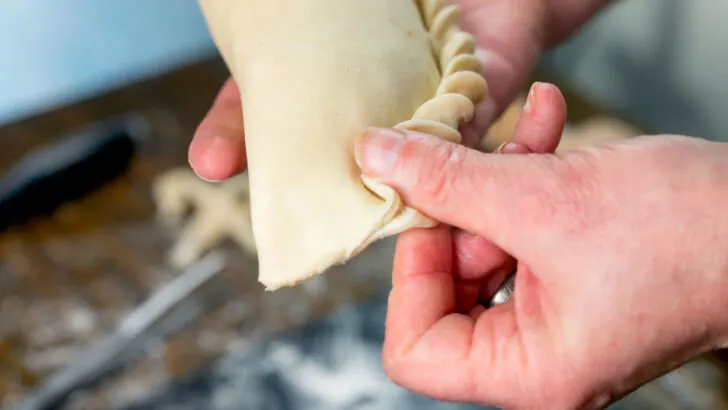
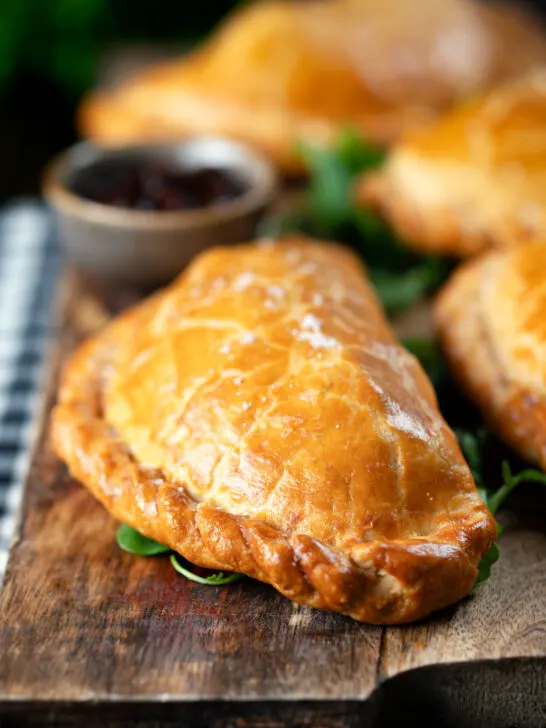
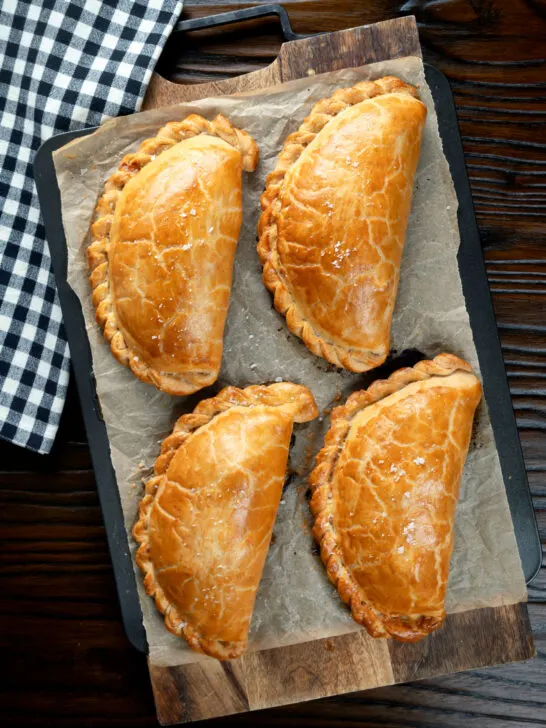
Cecilia
Sunday 18th of December 2022
I am a Brazilian trying to make a British dish in the USA! I was wondering what type of potatoes is the best to use. But anyways, love the recipe, thank you tons!
Brian Jones
Sunday 1st of January 2023
Hey Cecilia, sorry it took a while to respond, I was away over the holidays. You want a floury (mealy) potato for this recipe something like a russet would be ideal.
Enjoy
Pam
Monday 14th of November 2022
I see carrots in the picture but not in the ingredients list.🧐
Brian Jones
Wednesday 16th of November 2022
You are seeing swede and the lighting is giving it a bit of an extra pop of orange, but it's definitely swede. I remember that I had to grow it because I could not buy it in Hungary (where I lived at the time).
Gina Strauch
Wednesday 21st of July 2021
I very much enjoyed making and eating these, though I must confess I made them with a turnip and venison as I had neither beef nor rutabaga.
I assume these pasties freeze well, but I would appreciate knowing whether to thaw them before reheating, or put them into the oven frozen.
I made the slow cooked rabbit legs with Indian flavors last week which was also a lovely meal. The success of both recipes makes me plan to prepare a different recipe from the website each week.
Brian Jones
Thursday 29th of July 2021
Hi Gina... Sorry it took a while to respond, I have been in the process of relocating.
I'm so glad that you found my site and that you are having such success, I'm loving the idea of a venison pasty so much that I will forgive the turnip lol :D
Yes, you can freeze a pasty although they are much better frozen uncooked, I cook from frozen in a moderate (170°C-180°C or around 340-350°F) oven until piping hot in the middle and nicely coloured up. You can defrost for slightly better results, but do not defrost all of the way, I find cooking them when they are slightly firmer gives more pleasing results.
Valerie Butler
Saturday 3rd of July 2021
I was born in Cornwall over 70 years ago and it was the first thing you learned to cook . we used Skirt beef, potatoes, onions and swede salt, pepper and a few drops of water for the gravy. And the twist was always down the middle with your initial and hoped yours did not burst and loose it’s gravy.
Brian Jones
Sunday 4th of July 2021
No splitting here, it took years to get my crimping technique right but now it is as tight as a tight thing :)
Pamela Jones
Sunday 22nd of November 2020
My mother was born and raised in Cornwall. She came to Canada as a war bride and brought with her a great talent for making Cornish pasties. My favourite was potato, onion and egg. The egg was beaten with a fork and poured over the potato and onion. Salt and pepper added. I now believe this version happened when she was short of grocery money. For my sister and I, it's such a wonderful memory and not one of being short of anything. I just may bake today!
Brian Jones
Monday 23rd of November 2020
That sounds superb, I'd be completely down with that as a munch, add some baked beans on the side and I'd be in nostalgia heaven! One of my favourites is cheese and onion with lots of mustard :D